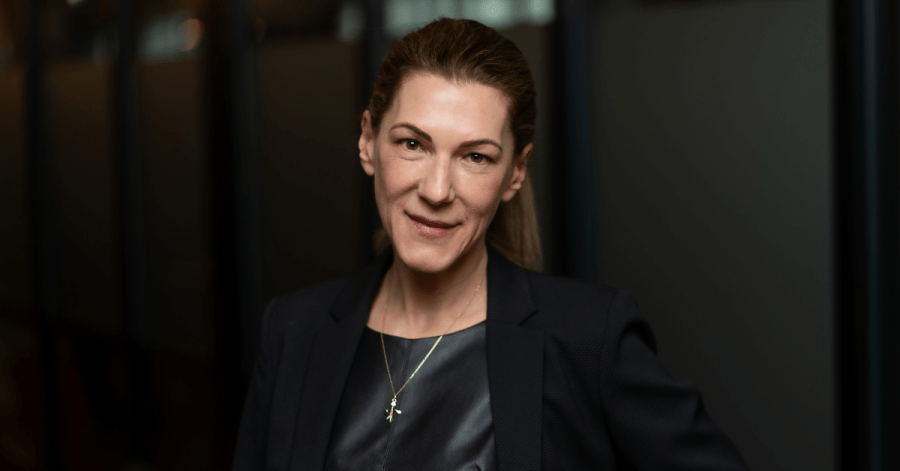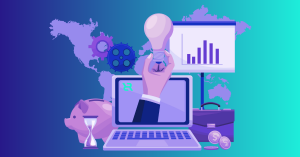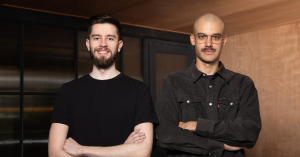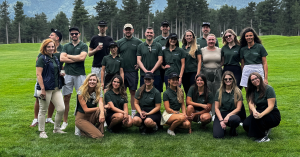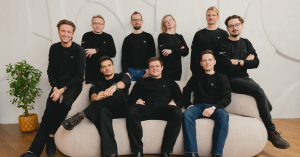• In a first move towards executing its vision to consolidate investment in Europe, co-investment platform for tech startups SeedBlink acquires Symbid, a pioneer crowdfunding platform, based in the Netherlands.
• The two platforms have a joint network of 62K individual investors, and have contributed over €110M of investments in 250 startups.
• The Recursive talked to CEO and Managing Partner Carmen Sebe about the strategic importance of the acquisition, her perspective on good leadership, and what comes next for SeedBlink.
There is still room for growth in the European tech scene. Building an investment infrastructure that bridges available European capital and innovative entrepreneurs with big ambitions is a key step towards higher competitiveness for Europe. This belief has persuaded Symbid and its founder Robin Slakhorst to join forces with their much younger, Eastern European crowdfunding platform fellow, SeedBlink.
Symbid is one of the first investment crowdfunding platforms, going back to 2011, when it was founded by a team of Dutch entrepreneurs. In 10 years of operation, they have facilitated investments totaling €35 million for more than 180 startups, 67 of which came from the technology sector.
Meanwhile, SeedBlink is one of the youngest and freshest players in the market, with an innovative approach to tech venture investment that brings together individual and institutional investors to fund top-tier European tech startups and scale-ups. The company has already mobilized over €75M, attracted over 12,000 individual investors from 60 countries, and built a portfolio of 62 funded European companies.
Next, learn more about what the deal means for SeedBlink, as well as about the leadership journey and lessons of CEO Carmen Sebe.
The Recursive: Can you walk us a bit through your career path so far, and how it has led you to your current position at SeedBlink?
Carmen Sebe, CEO of SeedBlink: I am an engineer and I also have a degree in management, which I earned a little later in my career. All my life I have worked in companies that make software. I specialized in being CEO of software companies that started in Romania with a great idea in a niche market and a small team of four to five people. As a CEO, I helped such companies build teams with hundreds of employees and succeed internationally.
I started a long time ago with a company called RAV Antivirus, which was sold to Mirosoft in 2003 – the first acquisition of the big technology group in Eastern Europe and a huge learning curve for me. After that, I was the manager of ePayment, a platform for payments, which was also acquired in 2010. My pride and joy until SeedBlink was Avangate, a payment platform for digital products that is now one of the largest in the world. I am still associated with the company because I built a great international team there.
After I left Avangate, I was introduced to the world of venture capital firms. I wanted to somehow give back what I had learned, especially by helping those who wanted to expand internationally. On that journey, I learned a lot about startups, founders, and startup funding. That eventually led me to found SeedBlink, which to me is a combination of a product and a venture capital firm, as we help technology startups raise money, and investors diversify their portfolios with promising opportunities.
What are the specific challenges and perks of running a company that sits between a product firm and a venture capital firm?
Challenges are associated with every type of startup, from funding to hiring. However, since our investment platform is very new in this part of the world, we still have a lot of education to do with both startups and investors. We are inventing everything as we go. For example, our strategy for investing in VC -backed startups is unique in the market. So in that regard, one of the biggest challenges is finding the right people. We can not “steal” from direct competitors because we do not have any.
What I would also like to mention here is that we are very lucky to have a team of two founders with complementary experience – two from the product side and two from the finance side. Together, they help each other understand different aspects of the business.
What were some milestones for SeedBlink since you joined as CEO that make you proud?
So we have a whole set of goals at the company level. Each goal is a milestone for us; we have metrics like revenue, number of investors, number of companies on the platform. As a company, we have achieved what we set out to do.
Personally, I am most proud of the fact that after two years I have managed to build a great team. To execute a great vision, you need great people, and they are hard to find and usually do not want to join a startup because startups are a risky business. So for me, having senior executives join a startup is a great achievement, especially since most of them have worked with me for a long time in previous jobs. In turn, they have built great teams themselves. A good manager always has people who want to work with them.
How did discussions for the acquisition of Symbid start, and what convinced you about the synergy potential of the partnership?
This is our first step in consolidating investments in Europe. At SeedBlink, we started discussions about such an acquisition at the beginning of the year; we were actively looking for companies within our reach that could help us grow. We were fortunate to have Symbid, the oldest crowdinvesting company in Europe, join forces with us as we are among the youngest in this niche in Europe. They bring a lot of experience, expertise and knowledge, and we bring freshness and an innovative approach, so we will be a good fit.
How will this acquisition help SeedBlink meet its goals?
SeedBlink wants to consolidate funding for technology startups in Europe, especially in terms of infrastructure. We know that Europe is currently very fragmented in terms of funding, as each country has its own environment. Nevertheless, as a result of crowdfunding regulation, Europe is opening the borders and encouraging investors to look at the continent as a whole. SeedBlink wants to build the infrastructure that allows European investors to invest across the continent. The caveat is that we only focus on technology that we are comfortable with and confident that we can find the right companies for our investors.
Symbid contributes with its knowledge because they have been in the market for a long time. We can learn from their successes, but also from their mistakes. Also, they come with investors from a part of the region we also want to enter – Western Europe. This is our next step, having already established a good footprint in the Balkans.
What will this union with a tech investor partner in the West mean for the Eastern European tech innovation ecosystem?
In Eastern Europe, there are a lot of underfunded startups that are extremely good and cost less at the end of the day. We are trying to bring together these startups with a great value proposition and wealthier investors from Western Europe. On the other hand, if we want to build an infrastructure for Europe, we need both sides. In Eastern Europe, we started organically – we have offices in Romania, Bulgaria and Greece, but in other parts of the world it is easier for us to make acquisitions.
You have an experience of more than 15 years as a CEO. What does a week look like for you as a CEO of SeedBlink?
The week is full of meetings, many of which involve discussing strategic issues with my colleagues on the executive team and the board. At this stage, I am also involved in some minor operational decisions, but not too many, as we have an experienced executive team.
I am involved in funding committees, which means I see a lot of startups and discuss with a lot of founders. I plan what we will have to do in the next week, next month, next half of the year. For example, now we discuss our goals for the first part of the year, review how the previous period went, what we should improve and so on. I am also hiring people. I talk to some suppliers, especially on some of the big projects. Sometimes I am also involved in events, interviews, or mentoring.
Based on your experience, how do you successfully adapt a company’s culture to rapid scaling?
It is easier to scale the business and keep the culture than to change it at a later date because the culture no longer fits. Otherwise, it’s better to start by establishing values that everyone can adhere to and then attract the people who fit those values.
Once you have those values, you need to work on communicating them, enforcing them, and sticking to them, whether through transparency, open communication, or otherwise. Team buildings and parties that everyone enjoys are a good time for the company to communicate and reinforce those values.
Ultimately, culture boils down to “how things are done around here,” from meetings to how we address each other to dress codes. To me, successfully building a culture means bringing your employees into your organization and helping them live your values. There are several tools that can help achieve this.
What do you think makes you good at what you do?
First of all, we do not yet know whether I am good or not. What I do to be good is to choose the right people for the right job. And then I let them do their job. I do not try to impose what I think should be done, and I let them have 95% independence in doing their job. I think that’s the key to being a good CEO. I do not try to be the smartest person in the room. I try to hire people who are smarter, who do their own jobs exceptionally well, and who can work well together.
How will you be measuring your success moving forward, as CEO of SeedBlink and a tech innovation ecosystem supporter?
Professionally, we have big plans for SeedBlink, we are very brave when it comes to moving forward. We want to be present in as many countries as possible in Europe, add crowdfunding to other investment forms and instruments, and eventually build an investment infrastructure for Europe.
We are taking this step by step and Symbid was the first step. We have plans for further acquisitions, opening offices in different countries, streamlining the acquisition process and taking further steps to bring even more and better companies to the platform. It’s not easy to get the best companies because everyone wants to invest in them. So we are fighting to make sure our investors get at least a few small checks.
On the question of what would be a good performance for me, I come back to what I said earlier, which is the team part. In my opinion, a good CEO is like an orchestra conductor – you do not have to be able to play the piano yourself, but you need a great piano player on your team. I want to be able to build a very good culture with great people, especially since we are all going through the hybrid challenge right now. At SeedBlink, we also have people on the team from all over Europe, which means we need to integrate different cultures. So my personal goal is to build a team that can execute our objectives smoothly and in a culture where they are happy and proud to work.
Help us paint a picture of the future of the startup ecosystem in Southeast Europe. What is one thing that will change for the better, and what is one thing that we already have and should keep with us moving forward?
I think the regional ecosystem has grown and evolved exponentially in the last two years. I expect more and more valuable tech startups to emerge in this part of the world and become unicorns. We have already seen homegrown companies reach valuations in the triple-digit millions in just a few years. This is because we have had more and more funding available for tech startups.
The ecosystem needs more local funds for all stages, strongly supported by Europe, which needs this level of technology to stay competitive. And we can not count on U.S. VCs to invest in early-stage European startups. Growth funds will also be more and more present. So we expect a simplified investment journey for a startup in the next few years that can help them stay here in Europe.
One element that is already present in the ecosystem and that I would keep and improve is the collaboration between different investors, VC companies and crowdfunding platforms across Europe. And finally, technology is of course one of the main strengths of our region that we need to maintain and capitalize on.

